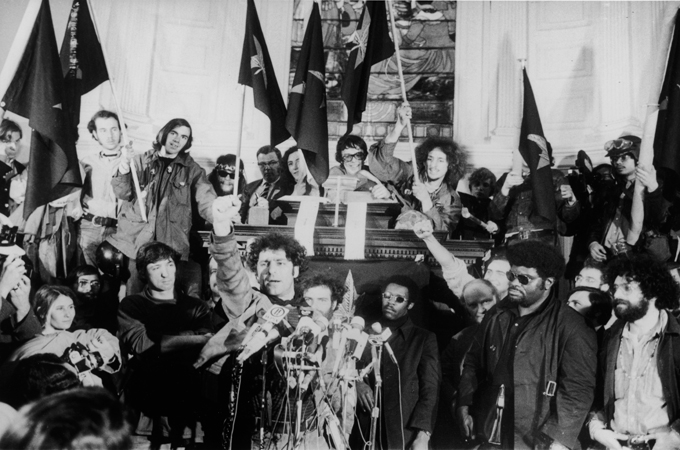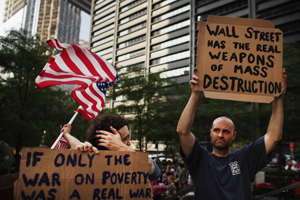Behind the scenes of #OccupyWallStreet
The protests on Wall Street are growing larger, despite police using pepper spray and making arrests.

 |
| Political activist Abbie Hoffman led protests against Wall Street back in the 1960s [GALLO/GETTY] |
Back in the 1960s, a gang of Yippies, a politicised arm of the hippies led by the late Abbie Hoffman, wormed their way into the tour of the New York Stock Exchange. While up on the visitors’ gallery, looking down on the trading floors, they threw US legal tender – coins and bills – at the men below who, when they realised what it was, began diving for dollars.
That colourful assault on the money culture took place 40 years ago on August 24, 1967. CNN recently remembered the moment, noting: “Some of the brokers, clerks and stock runners below laughed and waved; others jeered angrily and shook their fists.”
The bills barely had time to land on the ground before guards began removing the group from the building, but news photos had been taken and the Stock Exchange “happening” quickly slid into iconic status.
Once outside, the activists formed a circle, holding hands and chanting “Free! Free!” At one point, Hoffman – an old friend of mine – stood in the centre of the circle and lit the edge of a $5 bill while grinning madly, but an NYSE runner grabbed it from him, stamped on it, and said: “You’re disgusting.”
What disgusts some, inspires others, and that event is now firmly embedded in the legacy of the US left, which may have changed its character, but not its dislike of America’s Mecca of money and symbol of greed.
In the 1920s, the “Street” was bombed by anarchists, but a new non-violent breed today, holding on to the hatred of the wheeling and dealing that drives US capitalism – and perhaps global capitalism – have for the last week staged an encampment a few blocks north of the Exchange as a part of what they call #OccupyWallStreet.
The hashtag is a sign of their reliance on Twitter and other social media to organise a protest modelled after Tahrir Square (and perhaps Madrid’s Plaza Del Sol) where activists seized public space to launch a political movement. There is no central command, no orders from above. And you can watch the action online on a live stream.
This is not the usual approach to politics of an electoral kind with its traditional mobilisations and marches by mass organisations. It has attracted a group of wannabe revolutionaries, even as a right wing website called them a “menagerie” and others ridicule their youth, their hair, and their naiveté. It’s like a Wall Street Woodstock – so far without the music (but that might be coming) – as a number of celebrities have dropped by to show solidarity.
Had he lived, Abbie Hoffman would have been there to witness the takeover of nearby Zuccotti Park that has become the meeting ground of a growing bottom-up leaderless movement, drawn from several political traditions including libertarians, communists and environmentalists. Abbie now has 901,000 citations on Google.
Like the Egyptian movement they are emulating, there is no one political line or detailed set of demands, but it’s not clear if that matters.
 |
| The police have been accused of unnecessarily using mace and pepper spray against nonviolent protesters [GALLO/GETTY] |
Democratic movement
Decisions are made by a “general assembly” in which everyone can have a say. To speak, all you have to do is shout “mic check,” and, in call and response style, the activists present repeat your words, as they have been doing with the key ideas being expressed by speakers, so everyone can hear them. Sound systems, amplifiers and Public Address loudspeakers are not permitted by the city’s officials.
I observed a spirit of good-natured tolerance in the multi-generational group that numbers between a few hundred and a few thousand. They had hoped for 20,000 but that has not occurred yet, although one New York newspaper reported that, after New York Police arrested 80 marchers, using pepper spray and mace, the size of the protest actually grew.
Activists fear the police are looking for a pretext to shut down this fledging experiment in democracy, as the Wall Street companies want to get rid of people committed to defiance and resistance. At the same time, many of the ordinary cops in blue have been friendly – to the chagrin of their officers in white shirts. Chaz Valenza noted, “Employees and owners of several businesses harboured marchers to save them from arrest. And, a number of sympathetic NYPD officers treated those arrested with respect and extraordinary leeway, some expressing support.”
“The police officer told me he was going to cuff me very loosely so it wouldn’t hurt,” said one woman arrested on Saturday. Waiting in the bus she found the plastic strap cuffs were so loose her hands were not bound and she could freely take one out to use her cell phone.
Valenza offered this “box score” on the protests’ tenth day: “OWS Protesters Arrested: 121 – 200 (?); Wall Street Banksters Arrested: 0; People Power Hours since Day 1 (NYC only): 349,000 (an estimate of the amount of time activists invested).”
Critical mass
 |
| Police have denied protesters the right to assemble, putting up steel pens to block protesters [GALLO/GETTY] |
There is no doubt that Wall Street is a place millions of Americans love to hate, but protests take time to reach a critical mass – as they did in Egypt.
The event has triggered a sizable police presence perhaps because Wall Street, so close to “Ground Zero”, is a world financial centre. Ever since 9/11, the place had been militarised with an army of security forces and surveillance cameras.
Curiously, the protest is against Wall Street tactics such as “securitisation” in its trading, even as the area itself is securitised – with no protests allowed at the Stock Exchange, a private company patrolled by New York City police at taxpayer expense.
So much for freedom of speech and assembly, when you want to take on the most powerful plutocrats in the USA.
Yves Smith, who edits NakedCapitalism.com, a leading financial website wrote: “Welcome to the Police State”, noting, “I’m beginning to wonder whether the right to assemble is effectively dead in the US. No one who is a wage slave (which is the overwhelming majority of the population) can afford to have an arrest record, even a misdemeanor, in this age of short job tenures and rising use of background checks.”
The police like to put up steel pens in the streets to block congregations. They are literally turning Wall street into a walled off area, even as Rupert Murdoch’s New York Post headlined it “Fall Street”, commenting on the crashing markets.
This Great Wall of New York is nothing new. The first wall on Wall Street was built to keep Indians away. For many years, the area was taken over as a breeding ground by pigs, until a huge fire consumed the neighbourhood in 1832. What a nefarious history.
Freedom of the press is also at risk, as most top media outlets initially ignored, downplayed or scoffed at the protest. It took mass arrests for them to consider it newsworthy. As the website AmpedStatus.com noted, there has also been censorship:
|
“Twitter blocked #OccupyWallStreet from being featured as a top trending topic on their homepage. “ – AmpedStatus.com |
“On at least two occasions, Saturday September 17 and again on Thursday night, Twitter blocked #OccupyWallStreet from being featured as a top trending topic on their homepage. On both occasions, #OccupyWallStreet tweets were coming in more frequently than other top trending topics that they were featuring on their homepage. This is blatant political censorship on the part of a company that has recently received a $400 million investment from JP Morgan Chase.”
Despite the spotty and often sneering press coverage – there is no Al Jazeera here, as there was in Cairo with around the clock coverage – word of the protest has spread, and will continue to spread. Activists from around the country and the world are arriving at the action – originally called for by the Canadian magazine AdBusters.
These events radicalise participants, and spotlight Wall Street abuses just as they call attention to media complicity and police brutality.
Ten days on, the persistence of the Occupy Wall Street protest is a minor miracle in itself, surprising a cynical media and even activists who weren’t sure if they could pull off a sustained attack on financial power. Young people are showing how political they can be – in part, no doubt because so many are out of work and deeply in debt.
What will #OccupyWallStreet accomplish? Its existence is an accomplishment in itself. Writes Nathan Schneider on Reader Supported News: “For many Americans, nonviolent direct actions like this occupation are the best hope for having a political voice, and they deserve to be taken seriously as such.”
As for the future, that remains to be seen.
 |
| Despite officials’ efforts to end it, the #OccupyWallStreet movement has gained momentum [GALLO/GETTY] |
News Dissector and blogger Danny Schechter called for protests in his film Plunder: The Crime Of Our Time, exposing financial crimes on Wall Street. Comments to dissector@mediachannel.org
The views expressed in this article are the author’s own and do not necessarily reflect Al Jazeera’s editorial policy.
